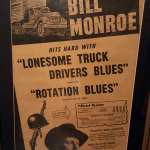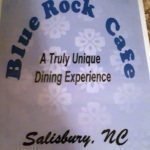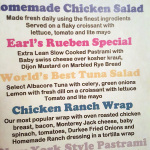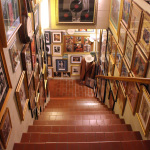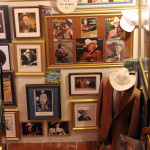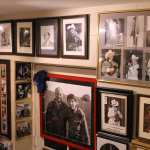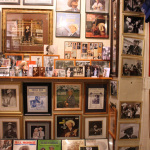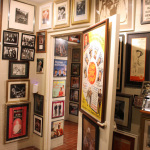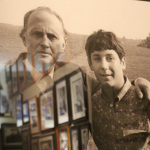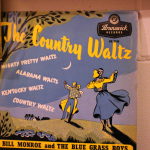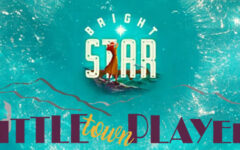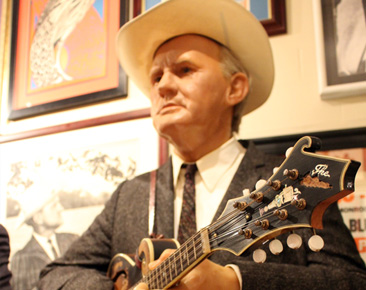
Our friend Becky Johnson, also known by her ‘street name’ of Mrs. Bluegrass, recently visited mandolinist and music collector Tom Isenhour and shared this article and photographs for our readers.
 For Tom Isenhour it all started with board games, toys associated with TV shows, and a spacious basement in his parents’ west Salisbury, North Carolina home. Then his older brother heard Earl Scruggs play the banjo, and he wanted Tom to back him on rhythm guitar. Music became a new passion with competing in fiddlers’ conventions all over piedmont North Carolina, going to the local radio station to watch bands do their shows, watching Flatt & Scruggs and Reno & Smiley on TV, and attending concerts.
For Tom Isenhour it all started with board games, toys associated with TV shows, and a spacious basement in his parents’ west Salisbury, North Carolina home. Then his older brother heard Earl Scruggs play the banjo, and he wanted Tom to back him on rhythm guitar. Music became a new passion with competing in fiddlers’ conventions all over piedmont North Carolina, going to the local radio station to watch bands do their shows, watching Flatt & Scruggs and Reno & Smiley on TV, and attending concerts.
On the way to a Flatt & Scruggs concert, early teenaged Tom decided to tear a poster for the show off of a telephone pole. For reasons he no longer recalls, he took the poster to Lester and Earl and got them to autograph it. From that simple start one of the great private collections of bluegrass memorabilia grew.
Actually, Tom has put together an astounding collection of music items ranging well beyond bluegrass. Life sized statues of Monroe, Flatt & Scruggs, and Hawkshaw Hawkins that he rescued from a failed Nashville wax museum have a great view of unbelievable Byrds, Gram Parsons and Flying Burrito Brothers, Buffalo Springfield, Dave Apollon, Beatles, and Elvis Presley items. Just one example is the letter Capitol Records sent to reviewers and DJ’s asking for the return of the legendary “butcher cover” of Yesterday and Today by the Beatles.
While the TV memorabilia provides Tom’s income, you can see that his greatest love is for the musical items, and that bluegrass gets the most attention among them. Nothing can match actually visiting his collection, but these photos will do much better than words.
 Perhaps most impressive is that Tom has gone far beyond the popular categories like records, photos, instruments, and show posters, although he has thousands of these. He has Bill Monroe’s suits from the last five decades of his career with photos and record covers for which Monroe wore them displayed nearby. You can see a mandolin case that Tut Taylor built for Monroe in 1963 and belt buckles from deceased Blue Grass Boys Rudy Lyle and Frank Buchanan. Frank, freshly back home following his time with Monroe, was one of Tom’s bluegrass mentors. Besides the songbooks that musicians sold in the 78 rpm era when records were too fragile to take to shows, Tom has collected a stunning number of the much less common sheet music for bluegrass songs. Many of these items are autographed. Visitors can see tickets for both Fincastle bluegrass festivals, the four page Billboard magazine insert promoting the New Deal String Band, the first “hippie” bluegrass band to sign with a major label, and the contract the Dillards signed to be the Darlin’ Family on the Andy Griffith Show.
Perhaps most impressive is that Tom has gone far beyond the popular categories like records, photos, instruments, and show posters, although he has thousands of these. He has Bill Monroe’s suits from the last five decades of his career with photos and record covers for which Monroe wore them displayed nearby. You can see a mandolin case that Tut Taylor built for Monroe in 1963 and belt buckles from deceased Blue Grass Boys Rudy Lyle and Frank Buchanan. Frank, freshly back home following his time with Monroe, was one of Tom’s bluegrass mentors. Besides the songbooks that musicians sold in the 78 rpm era when records were too fragile to take to shows, Tom has collected a stunning number of the much less common sheet music for bluegrass songs. Many of these items are autographed. Visitors can see tickets for both Fincastle bluegrass festivals, the four page Billboard magazine insert promoting the New Deal String Band, the first “hippie” bluegrass band to sign with a major label, and the contract the Dillards signed to be the Darlin’ Family on the Andy Griffith Show.
Tom makes his museum available to anyone interested in such things, but asks that you contact him in advance prior to visiting to make sure that he is available.
The list of precious memorabilia in Tom Isenhour’s collection could go on and on infinitely. Better now just to marvel at the photographs.

